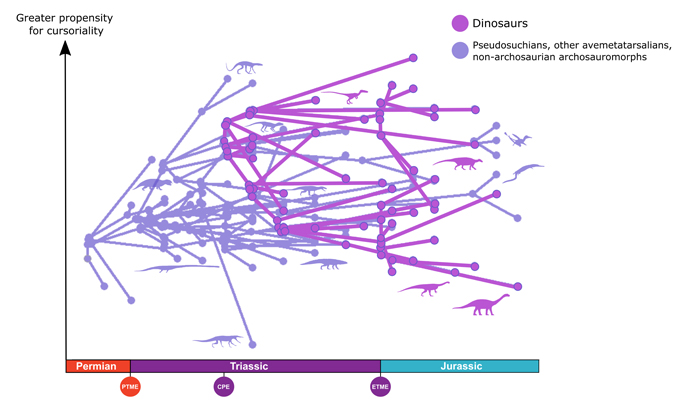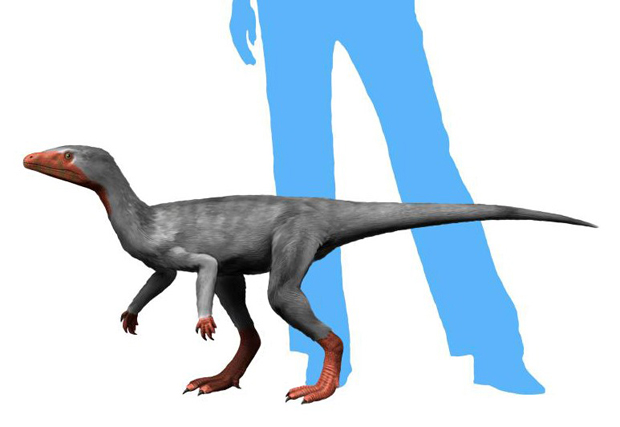Newly published research examining dinosaur locomotion and comparing it with other archosaurs suggests that the way in which dinosaurs moved could have given them a competitive advantage.
The research was undertaken by a team from the University of Bristol. It has been published today in Royal Society Open Science. The team’s findings indicate that the earliest dinosaurs were simply faster and more dynamic than their competitors. Perhaps the greater locomotor plasticity of dinosaurs gave them a distinctive advantage over other terrestrial animals. This may help to explain why the dinosaur/pterosaur/bird branch of the archosaurs, the Avemetatarsalia eventually outcompeted the archosaur crocodilian lineage (Pseudosuchia).
Studying Dinosaur Locomotion
The researchers compared the limb proportions of an extensive range of archosaurs that lived during the Triassic. In total, the limb proportions of 208 taxa were studied. The research team identified which of these tetrapods was quadrupedal (four-footed) or bipedal (two-footed). The cursoriality index of each animal was also examined. The cursoriality index is essentially a measure of running ability.
The results demonstrated that the earliest dinosaurs and their close relatives were bipedal and cursorial – they had limbs adapted for running. These animals, members of the Avemetatarsalia subgroup of the archosaurs had a much wider range of running styles compared to the other archosaur lineage, the Pseudosuchia.

A Higher Range of Locomotory Modes by the Avemetatarsalia
The Pseudosuchia include the ancestors of extant crocodilians. Some were small, bipedal insectivores, but most were medium-to-large-sized carnivores and herbivores, and they were very successful throughout the Triassic. The research team calculated that the Dinosauria and other members of the Avemetatarsalia, maintained a higher range of locomotory modes throughout this period.
Lead author of the study Amy Shipley commented:
“When the crunch came, 233 million years ago, dinosaurs won out”.
The MSc Palaeobiology student at the University of Bristol added:
“At that time, climates went from wet to dry, and there was severe pressure for food. Somehow the dinosaurs, which had been around in low numbers already for twenty million years, took off and the pseudosuchians did not. It’s likely the early dinosaurs were good at water conservation, as many modern reptiles and birds are today. But our evidence shows that their greater adaptability in walking and running played a key part.”

The End Triassic Mass Extinction Event (ETME)
Co-author of the paper, Professor Mike Benton explained that at the end of the Triassic there was a mass extinction event. Most of the pseudosuchians died out, except for the ancestors of today’s crocodilians. The surviving dinosaurs expanded their range of locomotion again, taking over many of the empty niches in food webs.
Co-author Dr Armin Elsler added:
“When we looked at evolutionary rates, we found that in fact dinosaurs were not evolving particularly fast. This was a surprise because we expected to see fast evolution in avemetatarsalians and slower evolution in pseudosuchians. What this means is that the locomotion style of dinosaurs was advantageous to them, but it was not an engine of intense evolutionary selection. In other words, when crises happened, they were well placed to take advantage of opportunities after the crisis.”

Could Dinosaur Locomotion be Key to Their Evolutionary Success?
Fellow collaborator Dr Tom Stubbs stated that the word “dinosaur” conjures up in the public’s imagination a slow-moving, large and lumbering animal. The first dinosaurs, animals such as Eoraptor lunensis were very different. The first members of the Dinosauria were small and agile.
Dr Stubbs said:
“The first dinosaurs were only a metre long, up high on their legs, and bipedal. Their leg posture meant they could move fast and catch their prey while escaping larger predators.”
Co-author Dr Suresh Singh concluded:
“And of course, their diversity of posture and focus on fast running meant that dinosaurs could diversify when they had the chance. After the end-Triassic mass extinction, we get truly huge dinosaurs, over ten metres long, some with armour, many quadrupedal, but many still bipedal like their ancestors. The diversity of their posture and gait meant they were immensely adaptable, and this ensured strong success on Earth for so long.”
Everything Dinosaur acknowledges the assistance of a media release from Bristol University in the compilation of this article.
The scientific paper: “Locomotion and the early Mesozoic success of Archosauromorpha” by Amy E. Shipley, Armin Elsler, Suresh A. Singh, Thomas L. Stubbs and Michael J. Benton published in Royal Society Open Science.
The Everything Dinosaur website: Everything Dinosaur.






Leave A Comment